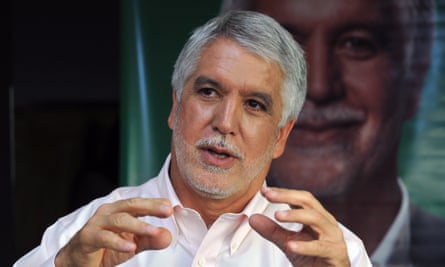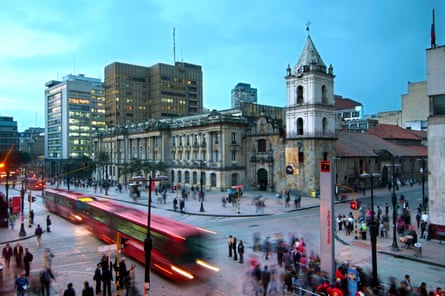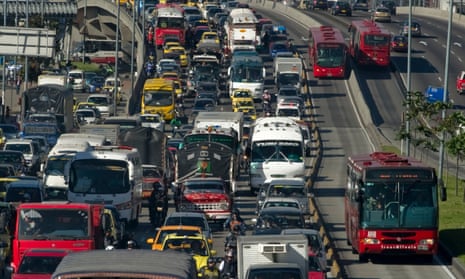Today marks the start of Habitat III, the UN’s once-every-20-years global summit on the future of cities. Why was the first one, in Vancouver in 1976, so significant for you?
EP: As the UN’s secretary general in charge of human settlements, my father [also called Enrique] organised that first Habitat conference. I was present as a student, and he shared many insights with me. It’s one of the reasons I became so interested in urban matters.
At university, I had believed that socialism would efficiently achieve high saving rates and high economic development – and produce greater equality. In fact I discovered it produced neither, so I became more and more interested in human settlements. I realised the way we build cities is much more important for the future happiness of people than economic development. For example, if we are able to save a couple of hectares of land for a public park, it can make people happier for thousands of years to come.
Forty years on, what is the most important issue cities need to tackle today?
Simply, land. Private property and the commercial market does not work in the case of land around growing cities – because when prices increase, the supply does not increase. It’s not like the market for potatoes, or ketchup.
The way cities grow should not be dictated by private interests, but by the government, which can identify the best places for development – to minimise transport distances and allow great parks to be created. Government intervention in land is crucial for the creation of good cities.
Wherever possible, we must protect the principal of the public good prevailing over private interests – meaning the power of “eminent domain” should be imposed frequently. It is crucial to maintain control of the land, and to be able to acquire land or buildings to public spaces, parks, roads and housing projects for the city.
There should never be private waterfronts in a democratic urban area. We are talking about the basic democratic principle which states that all citizens are equal. And if all citizens are equal, then all of them have the right to the same amount of road space, and the public good should prevail over private interest, and we should never have a golf course when there are no parks around.

You have long pioneered the importance of cycling and public transport in Bogotá. Do you feel vindicated by what you’re seeing in cities around the world today?
When we introduced bicycle paths in Bogotá nearly 20 years ago, when I was mayor here the first time, it was seen as a crazy idea. Back then, there were no bikeways in London, Paris, Madrid or New York. Now, of course, so many people are interested in this movement – particularly young people.
Cities that move by bicycle and public transport are more democratic, more egalitarian. In a “developing country”, a protected bikeway is not just a way of keeping the cyclist safe; it is a symbol that shows that a citizen riding a $50 bicycle is equally important to one driving a $50,000 car.
Yet most cities are still horribly clogged with traffic …
Mobility is a very peculiar challenge for a city – different from health or education – because it’s one problem that tends to get worse as societies get richer. But above all, we must understand that an advanced city is not one where poor residents use cars, but one where rich residents use public transport.
If all citizens are equal, then somebody who is walking or on a bike has a right to the same amount of road space as somebody in a Rolls-Royce or luxury car. And a bus with 150 passengers has a right to 150 times more road space than a car with one passenger. Which means we should give exclusive lanes to buses and create Bus Rapid Transit (BRT) systems; it’s the only solution.
In Bogotá, our BRT has the same speed and the same capacity as a subway; indeed, we move more passengers per hour than any subway in Europe. And in the future, we will ensure – either via the new subway or BRT lines – that more than 80% of the city’s population lives less than 1km from a mass transit line.
Bogotá has many problems and many failings, but one thing that is advanced here is that everybody accepts that buses should have exclusive lanes in every important road. Nobody questions that – even the people in cars who don’t like it, they don’t dare say it publicly.
The whole challenge of urban mobility is not an engineering challenge but a political one. Today, it’s almost as unjust and absurd to see a bus in a traffic jam as it was, a century or so ago, not to allow women to vote.

What do you think makes a good city?
I would say that a good city is one that is good for its most vulnerable citizens: for the poor, the elderly, for children and women. Crime-prevention is crucial in this, because normally when there is too much crime, those most affected are women, children or the elderly.
If you find trout in a mountain stream, it means the water is very pure, because the trout is a very delicate fish, susceptible to dirty water and a lack of oxygen. This is known as a “species indicator”.
In the same way, I have always said that a species indicator for a good city is to see children by themselves in a street, or elderly people, people in wheelchairs, or women by themselves. If women feel comfortable walking at night in a city, this is a good sign.
Conversely, crime is a huge problem for cities because it kills public space. I like to say that when shopping malls replace public space as a meeting place for people, it’s a symptom that the city is ill.
What should the priority be for everyone gathering in Quito for Habitat III?
The main urban challenges of course come in developing-country cities, which are growing very rapidly. Even in a Latin American city such as Bogotá, in a country like Colombia which is already largely urbanised [about 75-80% urban] – even here, the built area of the city will more than double over the next 40 years.
But in India, Asia and Africa, the built area of cities will increase by a multiple of 10 or more over the next 50 years – and therefore, I believe the biggest challenges are those cities that are yet to be built.
These are not only the biggest challenges but the biggest possibilities, because we can make cities that are totally different – and better than those that exist today.

I would say there is not one developing-country city with more than 50% of streets where someone in a wheelchair can go from one corner to the other. In most of these cities, it’s less than 10% of their streets.
The biggest problem for cities has to do with equity: the right to have access to a park, the right to have access to transportation, to have access not just to the obvious things – health, food, education – but also to sports facilities and music lessons, to green spaces, and things like this.
Should cities have more control over their own destiny?
Many people say that cities should be given more control by their national governments – but I think what’s even worse than having governments controlling cities is having a myriad of municipalities, each one doing whatever they want. It’s completely mad.
In Colombia, we have a constitution which gives a lot of independence to municipalities. If they are located exactly where a city needs to grow, they can simply decide “no”. And so that city is instead forced to grow very far away, in a low-density suburban development.
The important thing in the relationship between national and local government is that we redistribute resources and responsibilities in a rational way. We must create institutions where you can really plan a large city well, and redistribute income from rich areas to poor areas.
Would your father, organiser of the first Habitat conference, be pleased with the state of our cities today?
Well, we have certainly advanced a lot in conceiving what a good city is – and should be. But I believe that conception is too Euro-centric; too “advanced city-centric”, because I think developing-country cities which have not yet been built could be much better than London or Paris or New York.
For example, they could be criss-crossed by hundreds of kilometres of greenways. For London, say, it is impossible to have 2,000km of greenways criss-crossing it in every direction – it’s too late. But it’s very easy for the African and Asian cities that are yet to be built to have this.
There are so many possibilities to conceive a different kind of metropolis, for cities that are yet to be built. This is something you cannot do in New York or Paris, but it’s very easy to do in the new urban areas that are going to be built in Asia and African cities, and even in some parts of Latin America.
Right now, most developing-country cities really are not places for happy life; they are not places where rich and poor meet together in public spaces. They are very far from what good European cities are – and even further from the better cities that we could be making now.
Enrique Peñalosa is the current mayor of Bogotá. He was talking to Mike Herd
